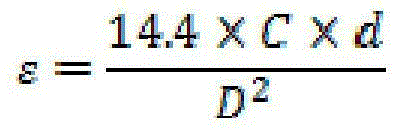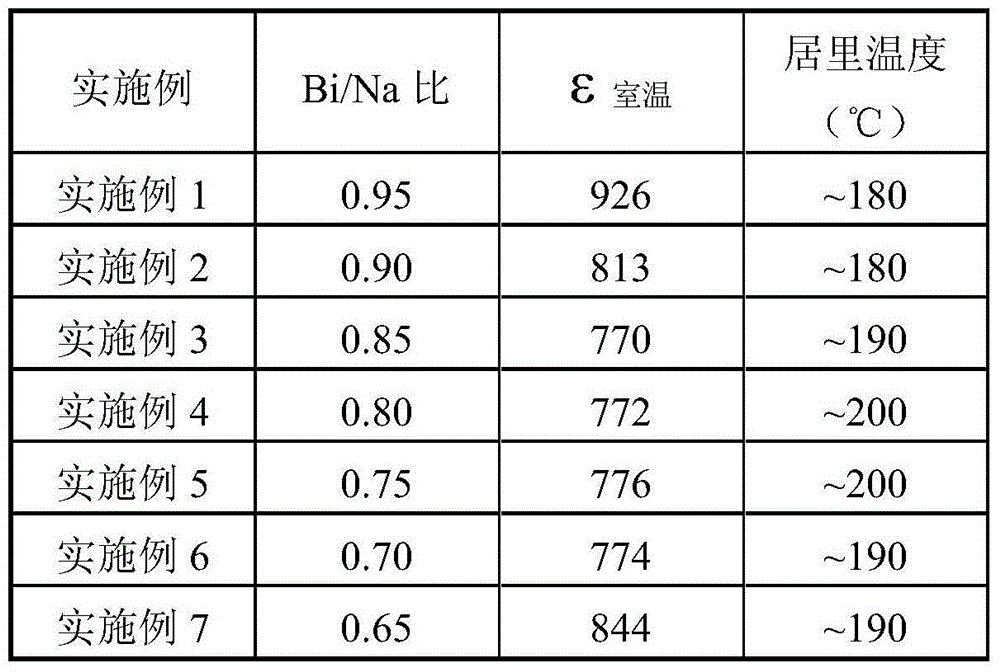Method for effectively improving Curie temperature of barium titanate-based dielectric material
A technology of dielectric material and Curie temperature is applied in the field of effectively increasing the Curie temperature of barium titanate-based dielectric materials, which can solve the problems of inappropriate addition amount and low dielectric constant at room temperature, and achieve the effect of increasing Curie temperature.
- Summary
- Abstract
- Description
- Claims
- Application Information
AI Technical Summary
Problems solved by technology
Method used
Image
Examples
Embodiment 1
[0016] 2.5013g Na 2 CO 3 , 7.5393g TiO 2 and 10.4468g Bi 2 o 3 Mix ball milling for 4 hours, dry, sieve, and calcinate at 950°C to obtain sodium bismuth titanate; mix 15g BaTiO 3 Mix 2.4048g sodium bismuth titanate with deionized water and ball mill for 4 hours, add 7% paraffin after drying, sieve and granulate; the powder after granulation is pressed into a green disc, and after 3.5 hours Raise the temperature to 550°C to expel the wax, raise the temperature to 1225°C for 1.5h to sinter, and keep the temperature for 1 hour to prepare the barium titanate-based dielectric material.
[0017] The upper and lower surfaces of the obtained barium titanate-based dielectric material are evenly coated with silver paste, and the electrode is prepared by firing at 850° C. to prepare a multilayer ceramic capacitor. Curie temperature and room temperature dielectric constant of embodiment 1 are shown in table 1.
Embodiment 2
[0019] 2.5013g Na 2 CO 3 , 7.5393g TiO 2 and 9.8970g Bi 2 o 3 Mix ball milling for 4 hours, dry, sieve, and calcinate at 950°C to obtain sodium bismuth titanate; mix 15g BaTiO 3 Mix 2.4048g sodium bismuth titanate with deionized water and ball mill for 4 hours, add 7% paraffin after drying, sieve and granulate; the powder after granulation is pressed into a green disc, and after 3.5 hours Raise the temperature to 550°C to expel the wax, raise the temperature to 1225°C for 1.5h to sinter, and keep the temperature for 1 hour to prepare the barium titanate-based dielectric material.
[0020] The upper and lower surfaces of the obtained barium titanate-based dielectric material are evenly coated with silver paste, and the electrode is prepared by firing at 850° C. to prepare a multilayer ceramic capacitor. Curie temperature and room temperature dielectric constant of embodiment 2 are shown in table 1.
Embodiment 3
[0022] 2.5013g Na 2 CO 3 , 7.5393g TiO 2 and 9.3472g Bi 2 o 3 Mix ball milling for 4 hours, dry, sieve, and calcinate at 950°C to obtain sodium bismuth titanate; mix 15g BaTiO 3 Mix 2.4048g sodium bismuth titanate with deionized water and ball mill for 4 hours, add 7% paraffin after drying, sieve and granulate; the powder after granulation is pressed into a green disc, and after 3.5 hours Raise the temperature to 550°C to expel the wax, raise the temperature to 1225°C for 1.5h to sinter, and keep the temperature for 1 hour to prepare the barium titanate-based dielectric material.
[0023] The upper and lower surfaces of the obtained barium titanate-based dielectric material are evenly coated with silver paste, and the electrode is prepared by firing at 850° C. to prepare a multilayer ceramic capacitor. Curie temperature and room temperature dielectric constant of embodiment 3 are shown in table 1.
PUM
| Property | Measurement | Unit |
|---|---|---|
| Curie point | aaaaa | aaaaa |
Abstract
Description
Claims
Application Information
 Login to View More
Login to View More - R&D
- Intellectual Property
- Life Sciences
- Materials
- Tech Scout
- Unparalleled Data Quality
- Higher Quality Content
- 60% Fewer Hallucinations
Browse by: Latest US Patents, China's latest patents, Technical Efficacy Thesaurus, Application Domain, Technology Topic, Popular Technical Reports.
© 2025 PatSnap. All rights reserved.Legal|Privacy policy|Modern Slavery Act Transparency Statement|Sitemap|About US| Contact US: help@patsnap.com



